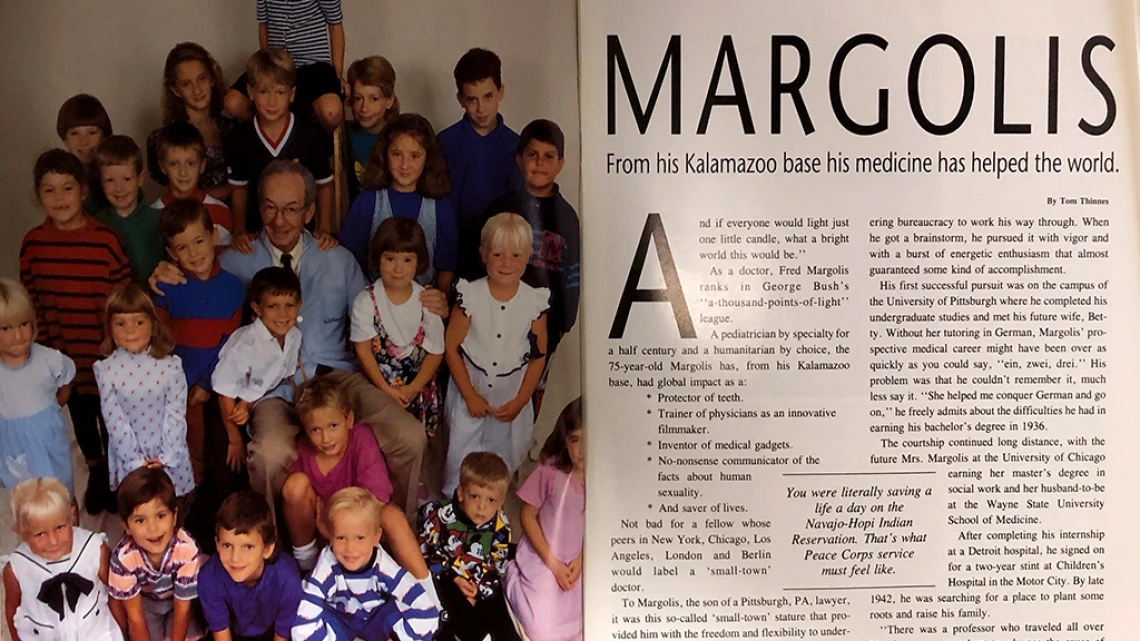Frederick J. Margolis photographs

Article featuring Dr. Frederick J. Margolis titled "Margolis: From his Kalamazoo base his medicine has helped the world.", pictured at center surrounded by children. Encore Magazine, 1990 (Box 1, Folder 6).
Collection dates: 1954-1956
This collection contains digital file images of color photographs taken (mostly) by Dr. Margolis between 1954-1956 in and around Fort Defiance, Arizona and in other locations in northern Arizona and northern New Mexico. The original photographic prints are not held in this collection; the PowerPoint is the source record from which digital file images are collected. Individual image files (JPEG format) were extracted from the PowerPoint and converted into TIFF-formatted files which are available upon request. To facilitate previewing, black and white PDF print surrogates are also included.
Several publications highlighting the work of Dr. Margolis have also been included. (403) color photographs are incorporated into a 434-slide PowerPoint presentation grouped into 21 categories. Most of the photos are captioned. An inventory of the images is coupled with the PowerPoint [DVD].
Included are photos of: family life; events/ceremonies; Fort Defiance hospital, medical personnel and patients; Navajo health educators; trips to the Canyon de Chelly, Monument Valley, Acoma, the Grand Canyon, Oak Creek Canyon and other locations. This collection is part of the Arizona Health Sciences Library (AHSL), a collection that focuses on the University of Arzona College of Medicine. It was transferred to Special Collections in 2018. Formerly collection number HT 0023.
Frederick Julian Margolis was born June 20, 1915 in Pittsburgh, Pennsylvania and died February 9, 1991 in Kalamazoo, Michigan at the age of 75. He received his MD degree from the Wayne State University School of Medicine in 1941, worked for two years at Children’s Hospital in Detroit and then settled in Kalamazoo in 1943, becoming the second pediatrician to practice in the area, (Dr. H. Sydney Heersma, being the first). Dr. Margolis and his wife, Elizabeth ("Betty") Hays Rieger Margolis (April 7, 1916 - December 14, 2011) lived most of their lives in Kalamazoo and raised a family there.
Fulfilling a promise to his wife to take a sabbatical after ten years of work, Dr. Margolis and family moved to Fort Defiance on the Navajo-Hopi Indian Reservation in northeastern Arizona in 1954 and worked there for two years as a U.S. Public Health Service physician at the Bureau of Indian Affairs Fort Defiance Hospital providing medical services to the Navajo and Hopi.
At Fort Defiance Dr. Margolis encountered various types of infectious diseases – some of which were resulting in high rates of infant mortality. He treated pediatric patients suffering from diarrhea and other gastrointestinal conditions, tuberculosis, pneumonia, measles, ear infections (that untreated could lead to meningitis), trachoma and other diseases.
While at Fort Defiance Dr. Margolis worked with other physicians including Kurt Deuschle MD (of the University of Kentucky Medical School and later Mount Sinai Hospital, New York) who was interest was in community medicine, Walsh McDermott MD, an eminent Cornell tuberculosis specialist, and George Shambaugh, Jr. MD, chair of the Northwestern University Medical School Department of Otolaryngology and a founder and president of the American Otolaryngology Association. Dr. Margolis also worked with members of the Native American community including traditional healers, medicine men Billy Norton and Denet Chili Bitsoi and Navajo community liaisons, Paul Jones, Navajo Nation tribal chairman, and Annie Wauneka, Navajo Nation tribal council member and health crusader. While in Fort Defiance Dr. Margolis recruited well-known film director, Rex Fleming, to Fort Defiance to create three public health patient education films on diarrhea, tuberculosis and sanitation. This was the continuation of a life-long interest on the part of Dr. Margolis in producing medical professional education and patient health education films (see "Margolis." Encore Magazine, September 1990).
In 1956 Dr. Margolis and family returned to Kalamazoo where he resumed what would become a 48-year career of providing service as a pediatrician to the families of Kalamazoo and beyond.
Dr. Margolis was perhaps best known for his work with fluoride and in sex education. He participated in local, national and international fluoride programs and was also instrumental in making Ipecac a household item for parents concerned about a quick antidote to accidental poisoning. In the 1960s he helped produce “Parent to Child About Sex” and the three-part “Sexuality and the Teen-ager” as well as many other films about human sexuality and good health. In the 1970s he created, produced and hosted a 13-part free-loan public service TV series called “Ounce of Prevention,” which was presented by the American Academy of Pediatrics under a grant from the Kellogg Co. of Battle Creek, Michigan. A second 13-part series, “Ounce Two,” followed. Later Dr. Margolis worked with the Kalamazoo Academy of Medicine in producing an educational film about AIDS.
In 1964 Wayne State University honored him for his distinguished professional contributions. In 1966 the Michigan State Dental Association honored him for his work with fluoride, one of his long-running interests aimed at reducing the incidence of tooth decay in children. Also in 1966 he was elected president of the Kalamazoo Academy of Medicine. In 1967 the Michigan State Medical Society presented him a special commendation. In 1970 he was given an honorary doctorate in public service from Western Michigan University and in that same year was named acting head of the Kalamazoo County Health Department and in 1973 the Michigan Department of Public Health gave him a centennial award.
A collection guide explains what's in a collection. New to using our collections? Learn how to use a collection guide.
Collection guideAccess this collection
Visit us in person to access materials from this collection. Our materials are one-of-a-kind and require special care, so they can’t be checked out or taken home.
How to cite
Learn how to cite and use materials from Special Collections in your research.
